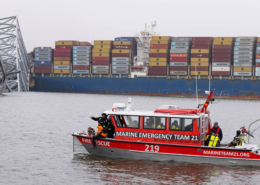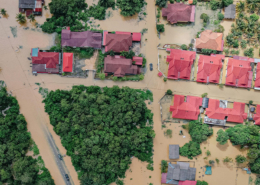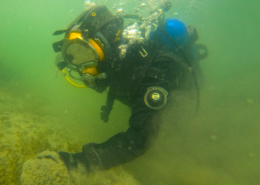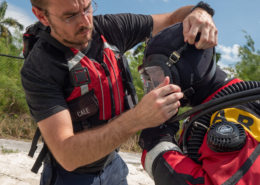How Public Safety Dive Teams and Investigators Work Together
By Detective Terry Kelley
As a Homicide Detective based in Columbus, Ohio, and a certified SDI Divemaster, I’ve witnessed the incredible synergy between my two roles. Recently, I had the privilege of working on several cases that required the expertise of our dive team. In this article, I’d like to share one such case where their exceptional skills and meticulous attention to detail significantly aided in my investigation.
The Chilling Discovery
The investigation began with a chilling discovery on a Sunday morning. Patrol officers received a call about a body found floating in a retention pond near a homeless camp. Medics and officers swiftly responded, tragically pronouncing the victim as deceased. Given the circumstances, our department’s dive team was the first to be summoned, as the victim was in a body of water. It’s important to note that the overnight temperature had dropped below freezing, and a thin layer of ice blanketed much of the retention pond.
Upon the arrival of the divemaster, before embarking on any rescue mission, he astutely began photographing the entire scene. This meticulous documentation included not only potential evidence but also the scene as a whole. You see, in many homicide cases, especially at the outset, the evidence is often elusive. But our divemaster, understanding that this was not a rescue operation, took the time to capture several photographs of items on the ice and scattered along the pond’s banks.
For Public Safety Dive Teams, Time Is of the Essence
Securing the scene and notifying the homicide unit naturally took time. I sometimes humorously describe the process as calls being routed through an operator in Guam, a detour through South American phone trees, and finally reaching the homicide sergeant, who then alerts the on-call team. While the bureaucracy persisted, the ice melted, and the evidence submerged.
When I finally arrived at the scene, I faced the daunting task of investigating with a very limited amount of evidence at my disposal. However, an unexpected turn of events changed everything. As I conducted witness interviews, I noticed members of the dive team donning dry suits, preparing to enter the water. My initial thought was a mixture of hope and concern, but when I approached the dive master to inquire, he shared the photographs they had taken before my arrival.
These images served as a critical piece of the puzzle. The evidence they captured in those photos not only corroborated witness statements but also expedited the identification of a suspect. Thanks to their dedicated efforts, the evidence was successfully recovered, playing a pivotal role in the eventual prosecution of the suspect.
A Closer Look at Public Safety Dive Team Operations
In the days following the scene’s processing, my team sat down with members of the dive team to review their response. I was taken aback by the level of documentation they had meticulously provided. I must confess; I had assumed that dive teams were merely a group of divers who showed up, got wet, searched for evidence, and then headed off for breakfast. However, I soon learned that they documented every facet of their response, from temperature readings to depth measurements.
Many dive teams may not fully comprehend the profound impact they can have on an investigation. Their insights and capabilities often go unrecognized. Dive teams are not typically summoned at the outset of a homicide investigation, but I can attest that if the response is prearranged and well-coordinated, it can be invaluable to the investigator and the evidence collection process. This, in turn, helps deliver the justice that grieving families rightfully deserve.
I strongly recommend that dive team leaders proactively engage with their investigative units to discuss expectations and the valuable contributions their team can make to an investigation. Standard Operating Procedures (SOPs) should be established, outlining specific roles and responsibilities, evidence preservation guidelines, and scene preservation protocols. Collaboration between dive teams, crime scene units, and investigative units is key to ensuring a seamless response.
The assistance of our dive team in that particular instance was not only helpful but also eye-opening. It highlighted the myriad ways in which a team of consummate professionals like ours can enhance an investigation. Their dedication, expertise, and commitment to thorough documentation make them an indispensable asset in the pursuit of justice.


 Photo By: Defense Visual Information Distribution Service
Photo By: Defense Visual Information Distribution Service


 Y. ZIN
Y. ZIN


Skriv en kommentar
Vil du deltage i diskussionen ?Du er velkommen til at bidrage !